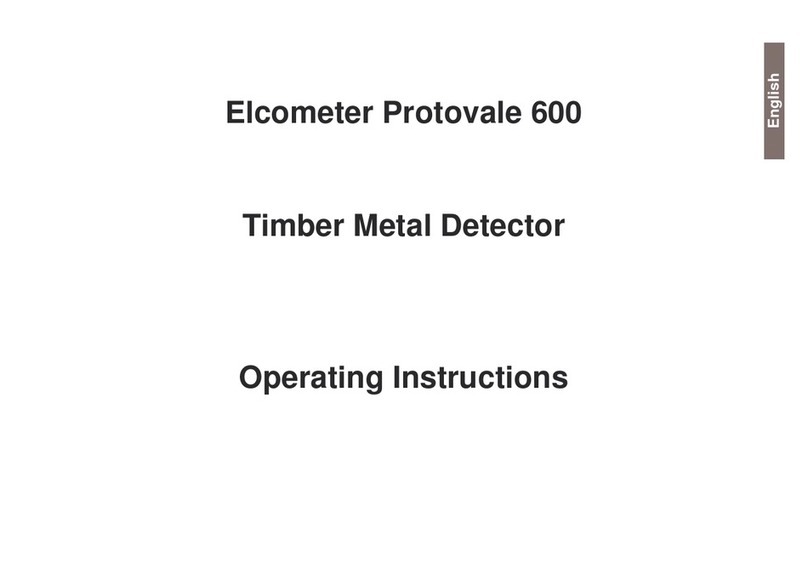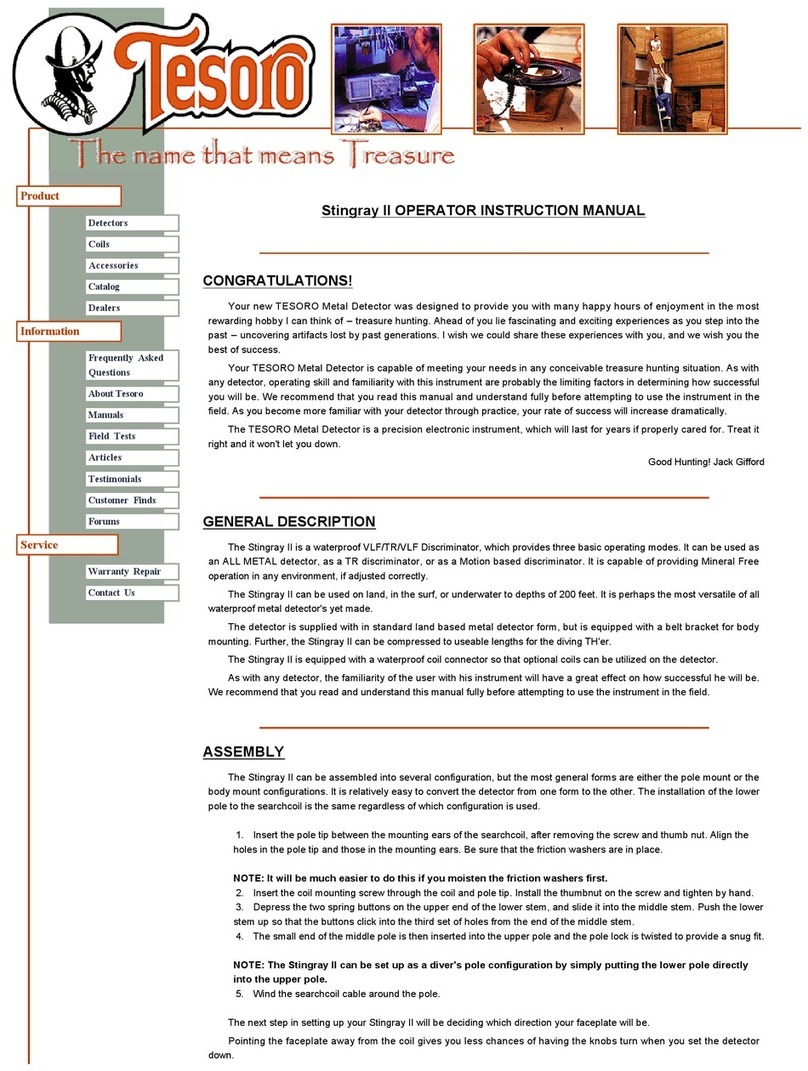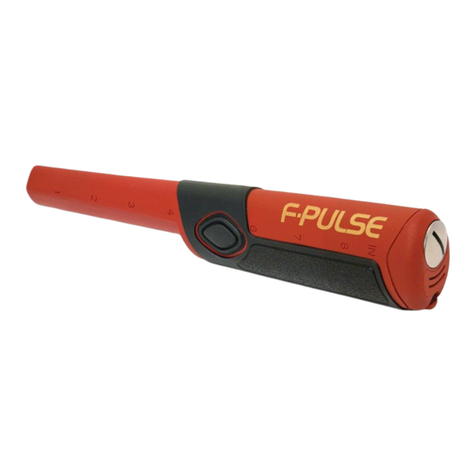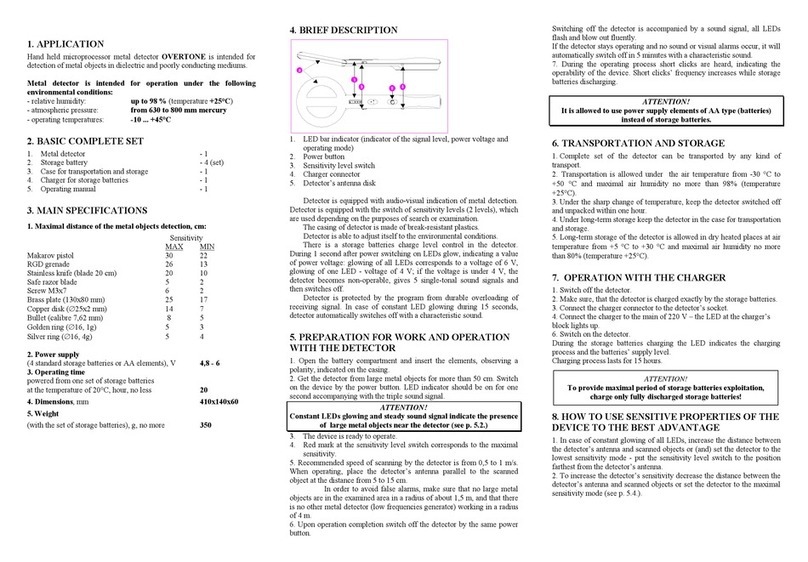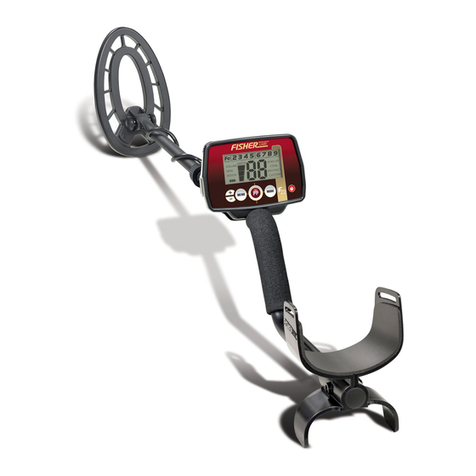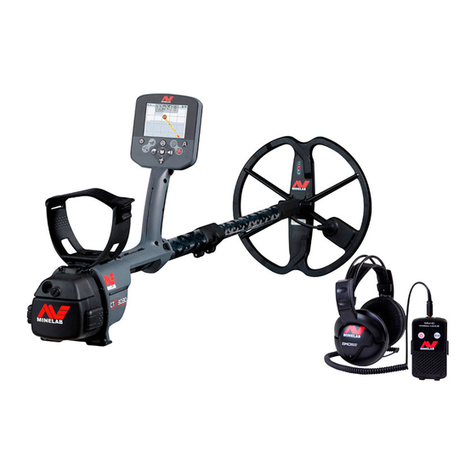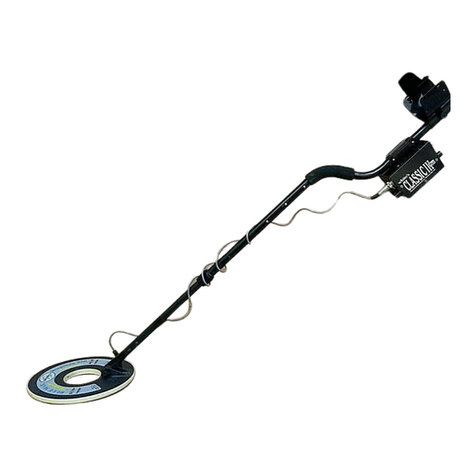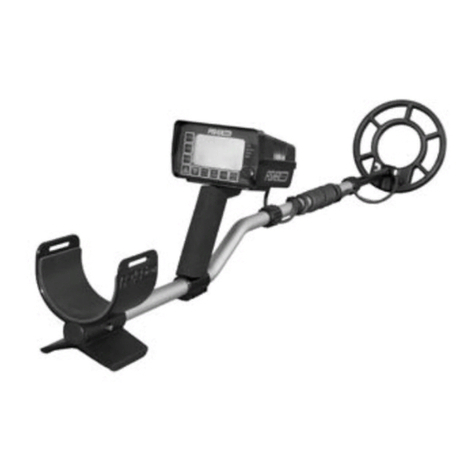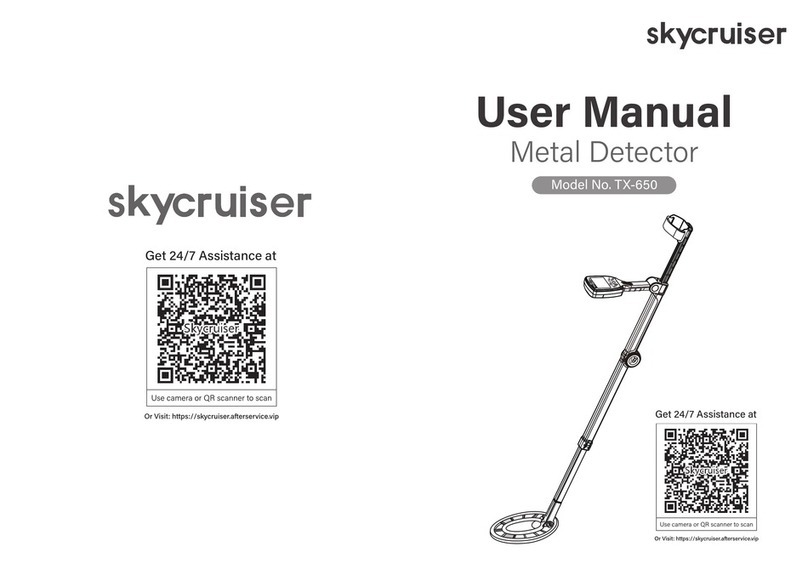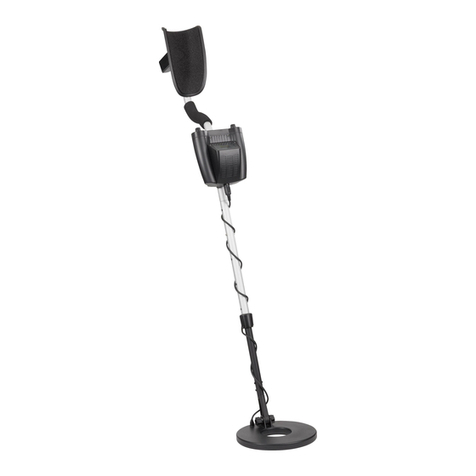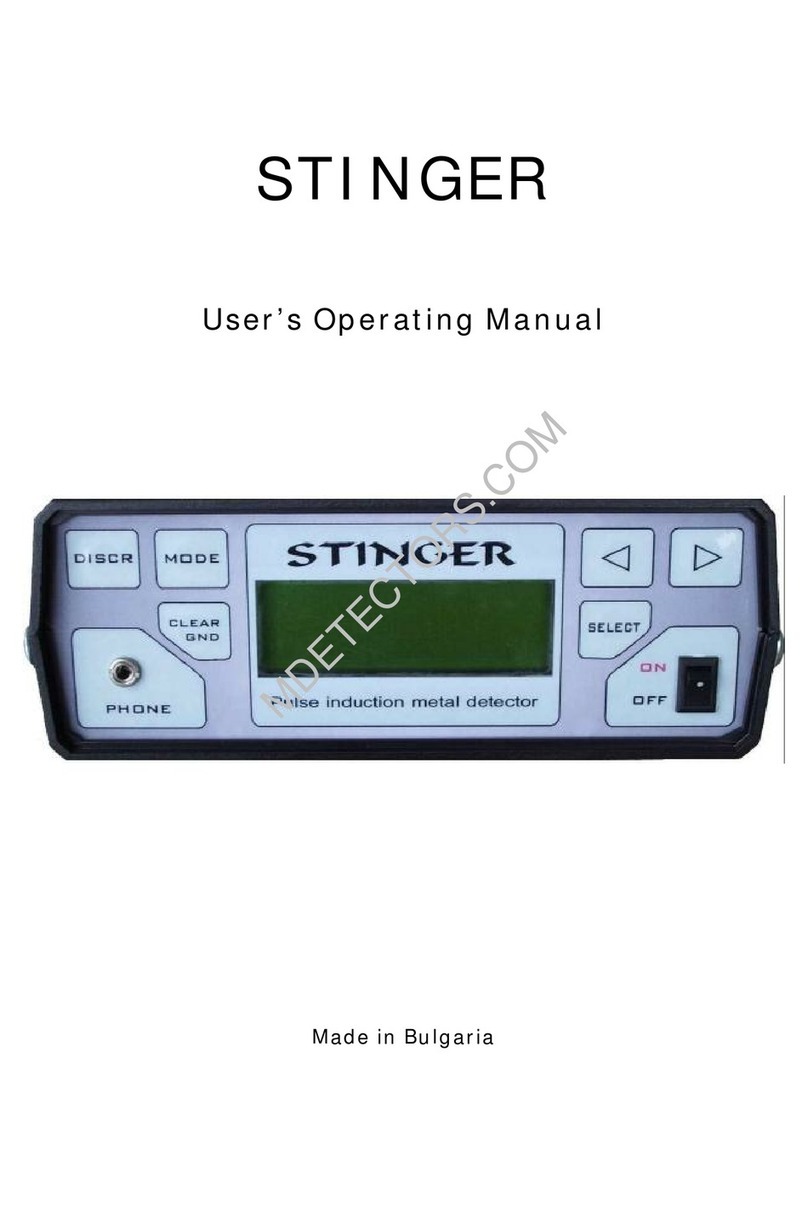Elcometer Protovale 610 User manual

English
Elcometer Protovale 610
Timber Metal Detector
Operating Instructions

English
This product meets the emc directive 89/336/EEC, amended 92/31/EEC and 93/38/EEC. The
Elcometer Protovale 610 Timber Metal Detector has been tested in accordance with EU
regulations governing Electromagnetic Compliance and it meets the required directives.
Note: Performance may be affected if the unit is operated within a radio frequency electromagnetic field
strength greater than 3V/m.
and Protovale are registered trademarks of Elcometer Instruments Ltd.
All other trademarks acknowledged.
© Elcometer Instruments Ltd. England 1996 - 2007
All rights reserved. No part of this document may bereproduced, transmitted, transcribed, stored (in aretrieval
system or otherwise) or translated into any other language in any form or by means (electronic, mechanical,
magnetic, optical, manual or otherwise) without the prior written permission of Elcometer Instruments Ltd.
A copy of this Instruction Manual is available for download on our Website via www.elcometer.com/downloads
Doc. No:TMA-0262 Iss. 02
Part No: 18056 Issue 01

1
CONTENTS
Section Page
1 About your Metal Detector . . . . . . . . . . . . . . . . . . . . . . . . . . . . . . . . . . . . . . . . . . . . . . . . . . . . . . . . . 2
2 Getting started. . . . . . . . . . . . . . . . . . . . . . . . . . . . . . . . . . . . . . . . . . . . . . . . . . . . . . . . . . . . . . . . . . . 4
3 Using the instrument . . . . . . . . . . . . . . . . . . . . . . . . . . . . . . . . . . . . . . . . . . . . . . . . . . . . . . . . . . . . . 6
4 Strong signals and target pinpointing . . . . . . . . . . . . . . . . . . . . . . . . . . . . . . . . . . . . . . . . . . . . . . . 7
5 Extraneous metal . . . . . . . . . . . . . . . . . . . . . . . . . . . . . . . . . . . . . . . . . . . . . . . . . . . . . . . . . . . . . . . . 7
6 Detector response to discrete objects . . . . . . . . . . . . . . . . . . . . . . . . . . . . . . . . . . . . . . . . . . . . . . . 8
7 Technical specifications. . . . . . . . . . . . . . . . . . . . . . . . . . . . . . . . . . . . . . . . . . . . . . . . . . . . . . . . . . 11
8 Spare parts and accessories . . . . . . . . . . . . . . . . . . . . . . . . . . . . . . . . . . . . . . . . . . . . . . . . . . . . . . 11
9 Maintenance . . . . . . . . . . . . . . . . . . . . . . . . . . . . . . . . . . . . . . . . . . . . . . . . . . . . . . . . . . . . . . . . . . . 12
10 Related equipment . . . . . . . . . . . . . . . . . . . . . . . . . . . . . . . . . . . . . . . . . . . . . . . . . . . . . . . . . . . . . . 12

2
Thank you for your purchase of this Elcometer Protovale 610 Timber Metal Detector. Welcome to
Elcometer.
Elcometer are world leaders in the design, manufacture and supply of inspection equipment for concrete
and coatings.
Our concrete inspection products include a comprehensive range of concrete, and civil engineering
inspection equipment. Our coatings products cover all aspects of coating inspection, from development
through application to post application inspection.
The Elcometer Protovale 610 Timber Metal Detector is a world beating product. With the purchase of this
instrument you now have access to the worldwide service and support network of Elcometer. For more
information visit our website at www.elcometer.com
1 ABOUT YOUR METAL DETECTOR
The Elcometer Protovale 610 Timber Metal Detector is a versatile instrument which has been designed to
find ferrous metal objects such as gate hooks, nails, staples and even shrapnel in timber, logs and wood of
all types.
1.1 FEATURES
• Auto-zero button - pinpoints the exact location of the metal object
• Analogue meter shows the signal strength - allowing you to identify the orientation of the metal object.
• Stable and reliable results - the instrument searches equally well through wet and dry, hot or cold,
hardwoods and softwoods.
• Socket for headphones (for noisy environments).

3
1.2 WHAT THE BOX CONTAINS
• Elcometer Protovale 610 Timber Metal Detector
• Search head
• Leather carry case
• Charger
• Operating instructions
The instrument is packed in a cardboard and foam package. Please ensure that this packaging is disposed
of in an environmentally sensitive manner. Consult your local Environmental Authority for further guidance.
To maximise the benefits of your new instrument, please take some time to read these Operating
Instructions. Do not hesitate to contact Elcometer or your Elcometer supplier if you have any
questions.

4
2 GETTING STARTED
2.1 CHARGING BATTERIES
The Elcometer Protovale 610 Timber Metal Detector is powered by internal rechargeable batteries.
A fully charged unit will give 9 or 10 hours of operation.
1. Make sure the instrument is switched to the OFF/CHG position.
2. Insert the coaxial plug of the charger into the CHARGE socket on bottom panel of instrument, and plug
charger into mains outlet.
After about half an hour the charger will normally become slightly warm to the touch. The unit will be
fully charged in 10 to 12 hours, or overnight.
A partially discharged battery can be ‘topped up’ by charging for as long as the period of discharge. Due to
the design of the charger supplied, no harm can come from overcharging, so if in doubt, leave on charge
overnight.
It is recommended that the batteries are not left for long periods without charging as this can damage the
batteries:
• if the instrument is used on a daily basis, charge the batteries at the end of each day,
• if the instrument is used infrequently, charge once a month.
Note: Nickel Cadmium batteries must be disposed of carefully to avoid environmental contamination.
Please consult your local Environmental Authority for information on disposal in your region.
Do not dispose of any batteries in fire.

5
2.2 CONNECTING THE SEARCH HEAD
Screw the TNC plug of the search head into the
socket marked ‘coil’ on the front panel of the control
unit, taking care not to cross the threads.
2.3 SWITCHING ON
Switch the machine on by turning the control marked
‘GAIN’ clockwise from the OFF position until it just
clicks on.
The instrument is now switched on, and set to minimum sensitivity.
2.4 BATTERY TEST
Press the button marked BATT/ZERO; a meter reading of 7 or over (within the green arc) indicates that the
batteries contain sufficient charge. If the meter reading is less than 7, the batteries should be charged - see
“Charging batteries” on page 4.
2.5 USING HEADPHONES
In noisy environments it may be easier to hear the signal if headphones are used.
Connect your headphones (not supplied) to the 3.5 mm jack socket fitted on the left-hand side of the case.
To switch off the sound to the speaker, use the switch marked SPEAKER MUTE/ON; this will mute the
sound from the speaker, but has no effect on the output from the headphone socket.
MUTE
ON
SPEAKER
BATT
TEST OFF CHG
GAIN
COIL

6
3 USING THE INSTRUMENT
1. Holding the search head well away from any metal, rotate the gain control fully clockwise and then
press and release the button marked BATT/ZERO. The instrument is now zeroed and set to maximum
sensitivity.
The unit will produce a faint tick-over sound.
2. Hold the search head above the ground and sweep the instrument back and forth.
When metal is detected, the meter deflects progressively to the right and the audible tone
simultaneously increases its ticking note past a low frequency buzz and progresses through a tone of
increasing pitch up to a high whistle.
If the search coil is scanned rapidly over an object, there is a slight time-lag in the onset of indication
and also in its dying away, so that the maximum signal appears just past the true position. If the coil is
moved more slowly, the lag is not noticeable and precise location is then possible.
The most efficient way to establish quickly the presence of metal is to operate the Elcometer P610 at
maximum sensitivity (GAIN control rotated fully clockwise); however having established the presence
of metal, the sensitivity can be progressively reduced by turning the GAIN control anticlockwise to
enable accurate pin-pointing of the metal object to within 5 cm to 8 cm.
The most sensitive point of the search head is its centre.
3. When you have finished detecting, remember to switch the unit off and, if necessary, recharge the
batteries.

7
4 STRONG SIGNALS AND TARGET PINPOINTING
Whereas the signal from an object at its maximum detection distance is weak, the signal from the same
object very close to the coil is between one hundred and one thousand times stronger and will cause the
circuits to overload. Whilst no damage is caused, this produces two effects: the unit will tend to give a
saturation signal over a wide area surrounding the object, and even when the coil is moved well away, the
indication will persist for a finite time until the circuits recover from the overload. To minimise this,
progressively turn the GAIN control anticlockwise.
Accurate pin-pointing may also be helped by moving the search coil into the region of strong signal, and
pressing the ZERO button to subtract the ‘edges’ of the response. If this is done, remember to re-zero the
instrument away from metal to restore full sensitivity before resuming searching. If the signal is still too
strong, try raising the search coil away from the object.
5 EXTRANEOUS METAL
Although the user may be searching for just one specific object, the instrument will react to all metal that is
within its detection range. This may yield a number of confusing extra responses, and indeed an object
which is nearer or larger than the target may well mask its presence. The user should therefore carefully
appraise the environment for suitability of application, bearing in mind extraneous metal.
Signals from objects such as structural metal (piles and girders), ferroconcrete, fencing and railings, and
pipelines and conduit will be received over long distances. Short-range signals can come from finger rings,
watches, metal toe-caps - even wooden benches and trestles containing screws.
Note: Always remember to keep the control unit well away from the search head - otherwise the control unit
will be detected also.

8
6 DETECTOR RESPONSE TO DISCRETE OBJECTS
6.1 OBJECT ORIENTATION
Non-magnetic (non-ferrous) objects give the greatest signal
when they present the largest area; thus a sheet of metal gives
the greatest signal when ‘face-on’, and the least when ‘edge-
on’.
For magnetic (ferrous) objects (e.g. iron or steel) the signal is
‘magnified’ by its length-to diameter ratio; this means that the
greatest signal will often be received when the object is being
‘looked at’ end-on.
These comments apply when the object lies on the ‘axis’ of the
coil, i.e. on the line through its centre (either above or below),
which is where most objects (but not all) give the greatest
response.
max min
max min

9
6.2 EDGE EFFECTS
In some cases, an object with a poor response under the centre
of the coil due to its unfavourable orientation will give a stronger
signal when under the edge of the coil.
In some cases therefore, a ‘difficult’ object will appear as two
sharp responses exactly one coil diameter apart, with the true
position halfway in between; this is particularly true of small iron
nails.
A special case is a long iron bar, when the response at the ends
is greater than that over the middle:
max minmin
max minmin
Non-ferrous
Ferrous
maxmedium

10
6.3 WIDTH OF RESPONSE
Mentally plotting the strength of response against position as theobject is scanned across can give yet more
information about the object:
A: A close object gives sharp responses as it crosses the edges of the coils
B: Distant objects give a more gradual decrease off-centre
C: Extended objects have a sharp response at their edges, and a ‘flatter’ response across their centre.
And two profiles you should NOT get:
D Signal too strong (object too large or too close) - reduce sensitivity
E Scanning too fast - slow down
The location of a single piece of metal in an environment that is cluttered with extraneous metal will
be difficult, if not impossible.
A B C D E
signal strength
movement

11
7 TECHNICAL SPECIFICATIONS
Control unit dimensions: 233 mm x 180 mm x 100 mm (9.2" x 7" x 4")
Search head diameter: 22 cm (8.7")
Weight: 850 g (1.87 lb)
Power supply: Internal rechargeable cells
APPROXIMATE DETECTION RANGE
Gate hook: 61 cm (24")
Barbed wire length 400 mm (15.7"): 36 cm (14")
Staple, length 40 mm (1.6"): 33 cm (13")
Nail, length 75 mm (3"): 33 cm (13")
Nail, length 125 mm (5"): 34 cm (13.4")
8 SPARE PARTS AND ACCESSORIES
The following replacement item is available from Elcometer or your local supplier.
Description Sales Part No.
200 mm (8") Search Head TW610197A

12
9 MAINTENANCE
The Elcometer Protovale 610 Timber Metal Detector is designed to give many years reliable service under
normal operating and storage conditions.
No special maintenance is necessary, though the unit should be wiped clean of dirt and moisture after use.
To prevent damage to the search head plug and socket, keep the threads dean and free from mud and grit.
The instrument does not contain any user-serviceable components. In the unlikely event of a fault, the
instrument should be returned to your local Elcometer supplier or directly to Elcometer. Contact details can
be found on the outside cover of these instructions, or on the Elcometer website, www.elcometer.com
10 RELATED EQUIPMENT
Elcometer produces a wide range of metal detectors and concrete and coatings inspection equipment.
Users of the Elcometer Protovale 610 Timber Metal Detector may also benefit from the following Elcometer
products:
• Elcometer Rebar Locators
• Elcometer Deep Cover Metal Detector
• Elcometer Concrete Covermeters
For further information contact Elcometer, your Elcometer supplier or visit www.elcometer.com
Table of contents
Other Elcometer Metal Detector manuals
